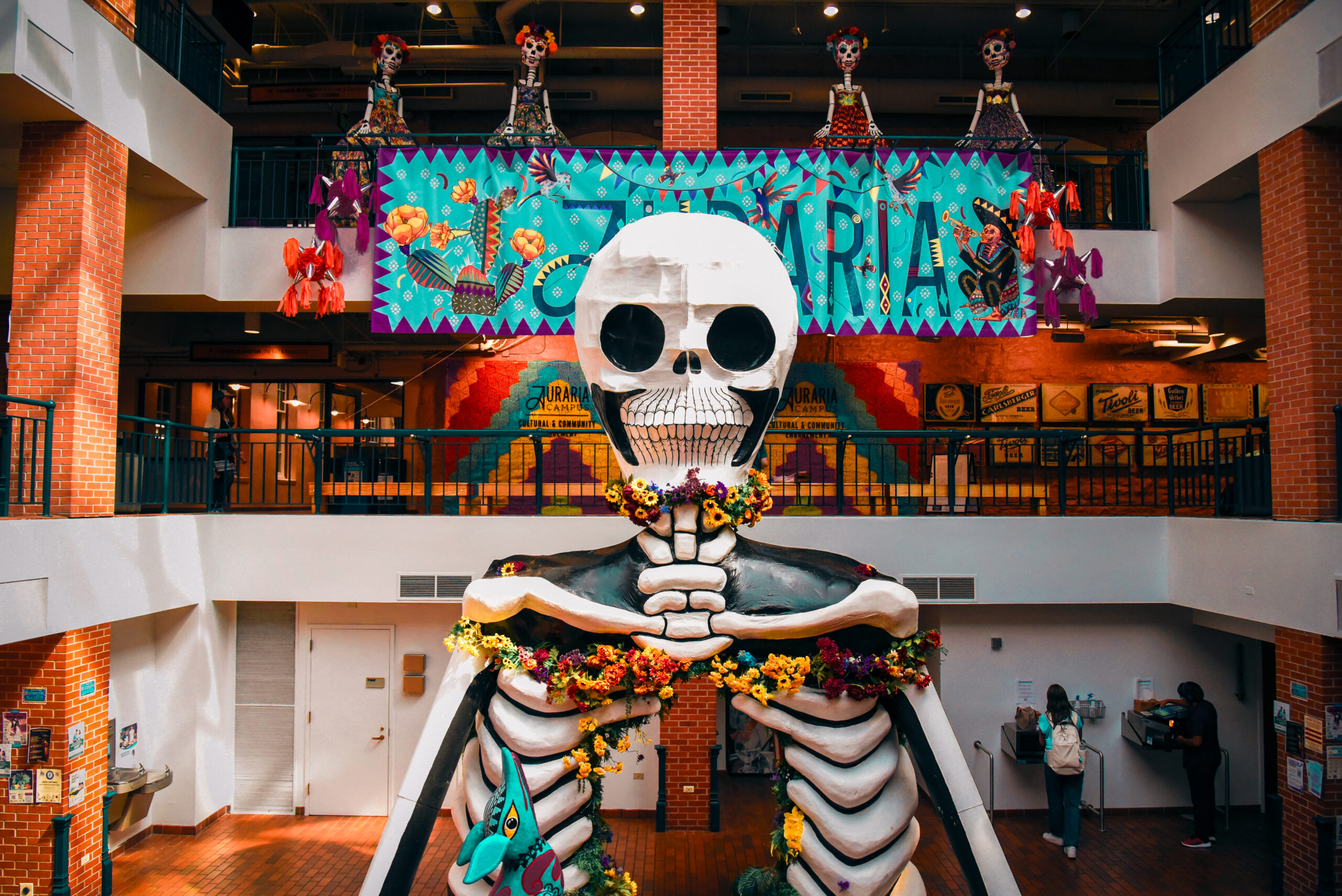
Posted
Auraria Campus Celebrates Hispanic Heritage Month with Cultural Installations
Auraria Campus is proud to celebrate Hispanic Heritage Month with vibrant cultural installations across the Tivoli Student Union, created in collaboration with students, staff, and community partners. These installations are more than decorations—they are symbols of heritage, community, and storytelling.
Share Your Experience!
We invite you to explore and celebrate the vibrant cultural installations on Auraria Campus this Hispanic Heritage Month. Take photos, share your favorite pieces, and tag us @aurariacampusdenver to join the conversation and show your appreciation for these amazing works of art.
Please respect the artwork. These installations are carefully crafted by talented artists and community members. Do not touch, climb, or move the pieces to ensure everyone can enjoy them safely.
Monumental Skeleton – Welcome to Mictlán
Cooperativa Jaén Cartonería | Denver, CO | 2024
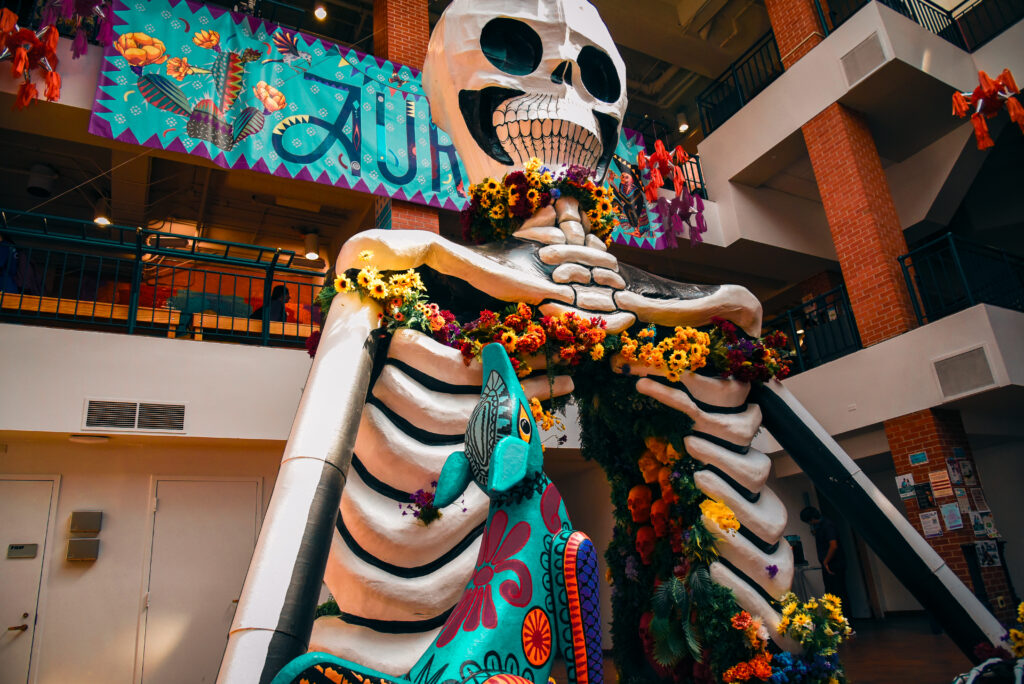
Auraria Campus is proud to showcase the Monumental Skeleton, Welcome to Mictlán – Mictlán is Welcome, hand-crafted in 2024 in Denver by the Mexico City-based Cooperativa Jaén Cartonería. This installation represents a historic collaboration between Jaén Cartonería and American artists and marks the collective’s first exhibition outside of Mexico. Catrinas en Mi Ciudad owns the only monumental skeleton pieces of Jaén Cartonería in the United States.
Founded in 2011 as a family project, Jaén Cartonería is dedicated to preserving the Día de Muertos tradition through monumental papier-mâché creations displayed in public spaces. Over the years, their work has gained national and international recognition for its artistry and cultural storytelling, including giant catrinas, masks, and elaborate themed exhibitions such as Mictlán Urbano.
The Welcome to Mictlán sculpture is made entirely of papier-mâché, a traditional craft that mixes pulped paper with starch paste or gum to create modeled objects. Papier-mâché is deeply rooted in global traditions and plays a central role in Mexican cultural expression, especially during Día de Muertos, where intricate sculptures of calaveras and symbolic figures adorn altars and streets. Beyond its visual impact, papier-mâché preserves cultural narratives, conveys spiritual and historical stories, and fosters community through collaborative creation.
The artwork carries two intertwined meanings:
- Cultural Connection: It symbolizes the blending of Mexican and American cultures, welcoming viewers to engage with Mexican traditions.
- Spiritual Portal: The giant skull opens its chest to form a “portal” between life and Mictlán, the resting place of souls. A path of candles leads the way, and a carpet of cempasúchil flowers guides the spirits home. This space honors the departed, inviting them to return and enjoy the foods, drinks, objects, and games they cherished in life.
Through its scale, symbolism, and artistry, Welcome to Mictlán exemplifies how papier-mâché transcends craft to become a powerful medium for cultural storytelling, remembrance, and celebration.
Backdrop Installation, -Cielo Tejido
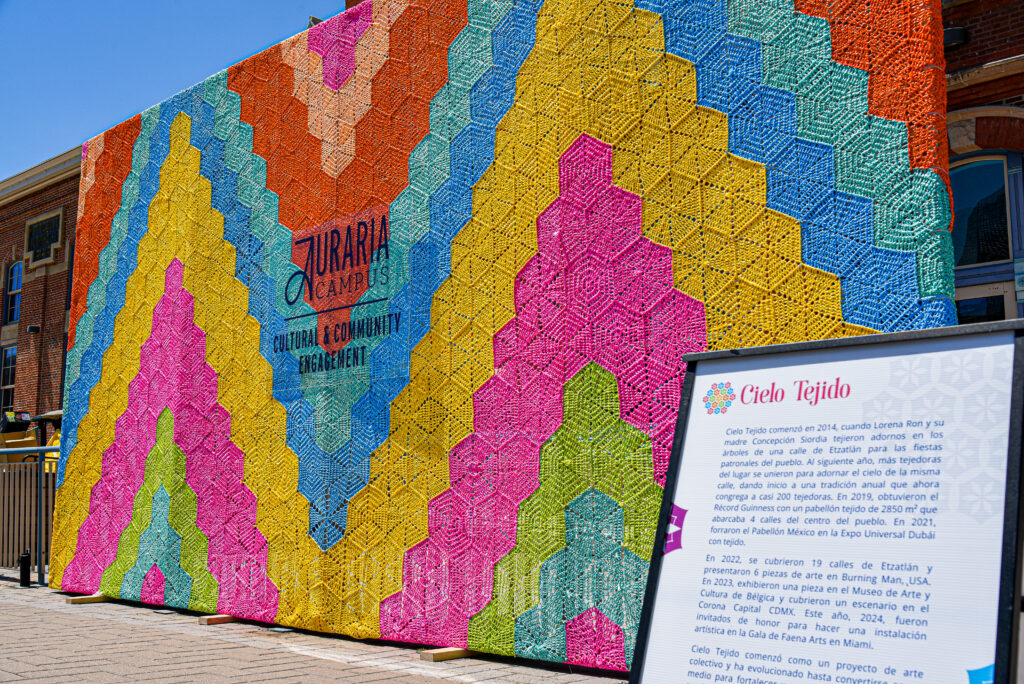
This handcrafted backdrop was created by Cielo Tejido, a collective founded in 2014 by Lorena Ron and her mother, Concepción Siordia, in Etzatlán, Mexico. What began as a small street installation during a local festival has grown into a tradition involving nearly 200 weavers.
Cielo Tejido is internationally recognized for its large-scale woven art, including a Guinness World Record pavilion in 2019, and installations at the Dubai World Expo and cities across Mexico, the U.S., and Europe. Each stitch represents community, identity, and intergenerational connection.
✨ We invite you to take photos with this vibrant piece and share your experience—don’t forget to tag @AurariaCampus!
The Spaik Legacy Banner, -Spaik (Israel Guerra)

Auraria Campus is honored to celebrate the life and legacy of Spaik (Israel Guerra Romero) through the Spaik Legacy Banner, designed in recognition of Hispanic Heritage Month. Spaik reimagined the Auraria Campus logo by weaving in Hispanic cultural elements, creating a design that honors both our campus identity and the rich traditions of the Hispanic community.
Spaik was also the artist behind Auraria’s Unidos mural, a piece that has become a vibrant symbol of unity on campus. His artistic journey began in 1999 as a graffiti artist, eventually evolving into muralism. Known for his vivid use of color, integration of animals, and deep cultural references, Spaik’s work earned international acclaim. His murals spanned the United States, Europe, and Africa, where his socially conscious and visually striking style resonated with diverse communities.
Beyond his art, Spaik was recognized by the Mexican Institute of Cinematographic and Humanistic Research as a distinguished fellow. Following his passing, the institute released a heartfelt tribute: “With profound sorrow, we bid farewell to Israel Guerra Romero, known as Spaik… You will live on in our memories and through your artistic legacy.”
Today, the urban art community in Tulum and around the world continues to feel the absence of a visionary whose work gave life and meaning to public spaces. Through the Spaik Legacy Banner, Auraria Campus honors his creativity, his heritage, and his enduring impact.
Piñatas
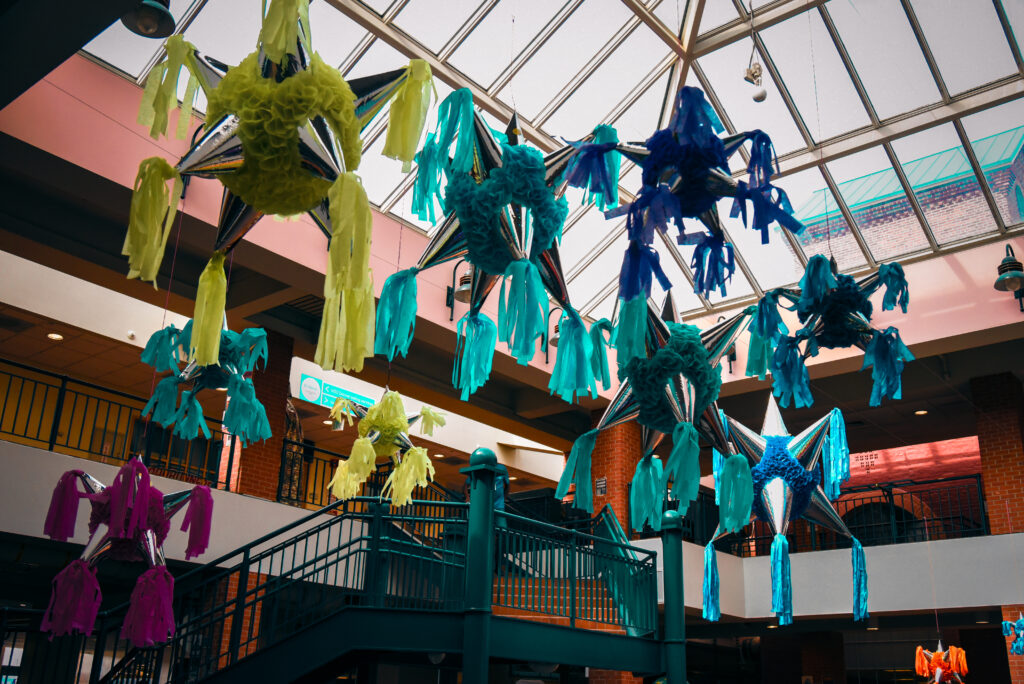
All the piñata’s were made by piñateros (piñata makers) in Ciudad Juárez, Mexico. Featured in two spots across campus, in the atrium and the west-side Tivoli entrance (across from Tivoli Turnhalle), are handcrafted piñatas, created in Mexico and brought here to celebrate Hispanic Heritage Month.
Piñatas hold deep cultural significance in Mexican traditions. Originally tied to religious ceremonies and celebrations, they have become symbols of joy, resilience, and community. Breaking a piñata is more than just a festive activity—it represents the triumph of hope and perseverance, as participants work together to release the rewards inside.
Today, piñatas are central to celebrations across Mexico and beyond, symbolizing both cultural heritage and shared joy.
Calaveras en Mi Ciudad, participating artists: Julio Mendoza & Armando Silva
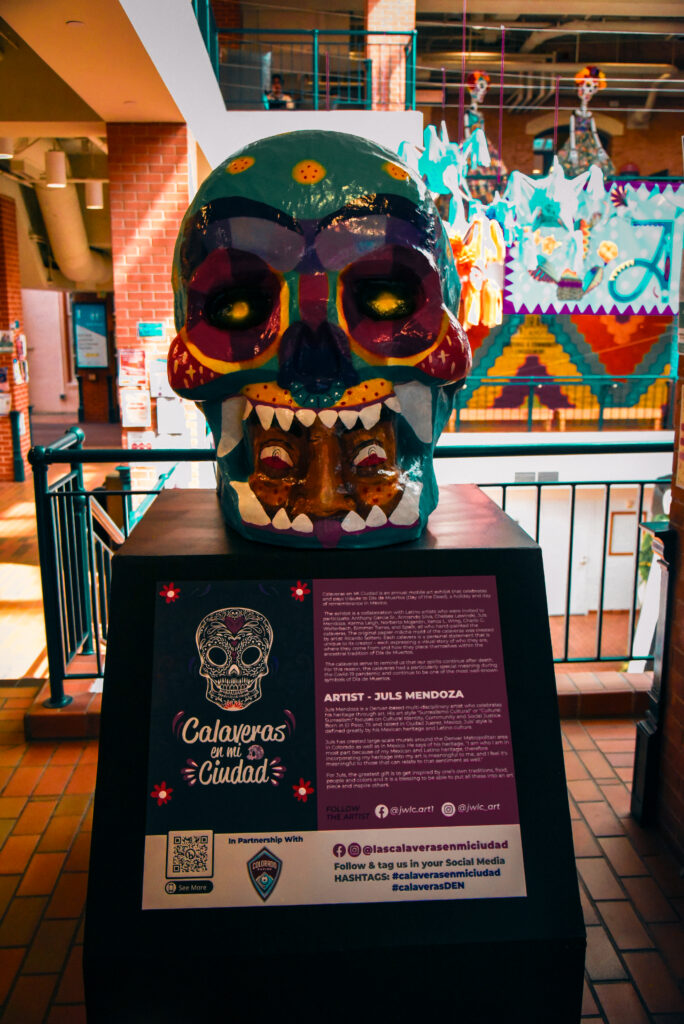
Catrinas en Mi Ciudad is an immersive art exhibit celebrating the art and traditions of Día de Muertos. Created to provide educational opportunities and showcase Mexican culture, the exhibit honors cultural preservation, creative expression, and public art in shared spaces.
Through vibrant installations, Catrinas en Mi Ciudad engages the Colorado community, strengthens connections, and provides experiential learning for youth. The project supports historically under-resourced local and national artists while fostering a sense of belonging in Denver. By encouraging families and children to explore diverse artistic expressions, the exhibit highlights the value of inclusion and representation in the arts.
Co-founders Alexis Newton and Marisol Villagomez aim to create a living history of Día de Muertos through monumental skeletons and colorful skulls, celebrating life while honoring loved ones who are no longer with us. Their vision demonstrates how art and storytelling can preserve cultural histories, inspire future leaders, and connect generations.
Alexis and Marisol are grateful to David Olguin and the Auraria Campus staff for supporting this celebration of cultural heritage. Following its display on campus, Catrinas en Mi Ciudad will continue with its free annual outdoor art exhibit at the Galeria at the Denver Performing Arts Complex, October 3 – November 3, 2025.
Calaveras
The two calaveras (skulls) in this exhibition were hand-painted by local artists Julio Mendoza and Armando Silva. Calaveras are the most recognizable symbols of Día de Muertos, reminding us that life continues even after physical death and helping to eliminate the fear of mortality.
Through these vibrant skulls, Catrinas en Mi Ciudad honors the traditions of Día de Muertos while showcasing the talents of both local and international artists. The calaveras contribute to a living history of the holiday and celebrate the heritage of Denver’s Latino community.
Tall Catrinas, -Ricardo Soltero
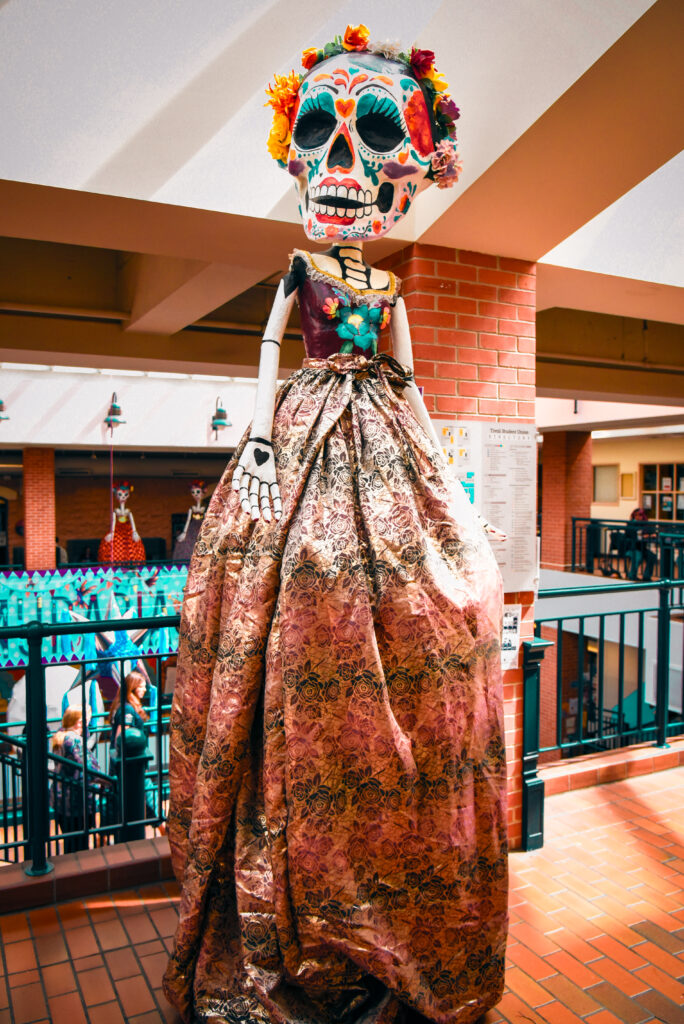
Auraria Campus is proud to feature the Tall Catrinas created by artist Ricardo Soltero, renowned for his larger-than-life renditions of La Calavera Catrina—one of the most iconic figures of Día de los Muertos.
Soltero first created his monumental Catrinas in 2011 for Hollywood Forever Cemetery in Los Angeles, home to the largest Day of the Dead celebration outside of Mexico. Standing 8 feet tall, these vibrant sculptures quickly became his artistic hallmark, introducing audiences around the world to the elegance and symbolism of La Catrina. Over the years, his works have grown to even greater heights—some reaching up to 26 feet.
As the longtime set designer for Hollywood Forever’s annual Día de los Muertos celebration, Soltero has brought new cultural motifs to the event each year. His distinctive designs even influenced Pixar’s award-winning film Coco, which featured elements inspired by his sets. While initially surprised, Soltero was later moved to see Hollywood Forever acknowledged in the film’s credits—a testament to the global impact of his artistry.
La Catrina, originally popularized by Mexican illustrator José Guadalupe Posada, is a satirical yet deeply symbolic figure. She reminds us that death comes for all, regardless of wealth or status, while also serving as a proud emblem of Mexican identity. Through his towering Catrinas, Soltero has reimagined this cultural icon on a monumental scale, blending tradition, artistry, and storytelling to honor life, death, and heritage.
Community Collaboration
A huge thank you goes out to the volunteers who helped bring these displays to life. The Auraria Campus cultural installations were brought to life with support from Journey Through Our Heritage (JTOH), one of the nation’s most innovative multicultural educational programs. Sponsored by MSU Denver’s Department of Chicano/Chicana Studies and Department of Africana Studies, JTOH partners college peer mentors with local middle and high school students to engage them in a year-long program that complements the public school curriculum in African American, Native American, Chicano/a, Mexicana/o, Mexican American, and Latina/o Studies.
Through their involvement, JTOH students contributed valuable energy, creativity, and hands-on support to help showcase these vibrant cultural displays, fostering a deeper connection between the campus community and the heritage being celebrated.
Learn more about Journey Through Our Heritage
Alexis Newton and the Calaveras en Mi Ciudad team also played a vital role in this year’s installations. Through her work in the Denver Hispanic/Latino community, Alexis and her team have been instrumental in sharing cultural knowledge, creating meaningful art, and fostering connections across generations. Their expertise and passion helped ensure that the installations authentically represent and honor Mexican and Hispanic traditions.
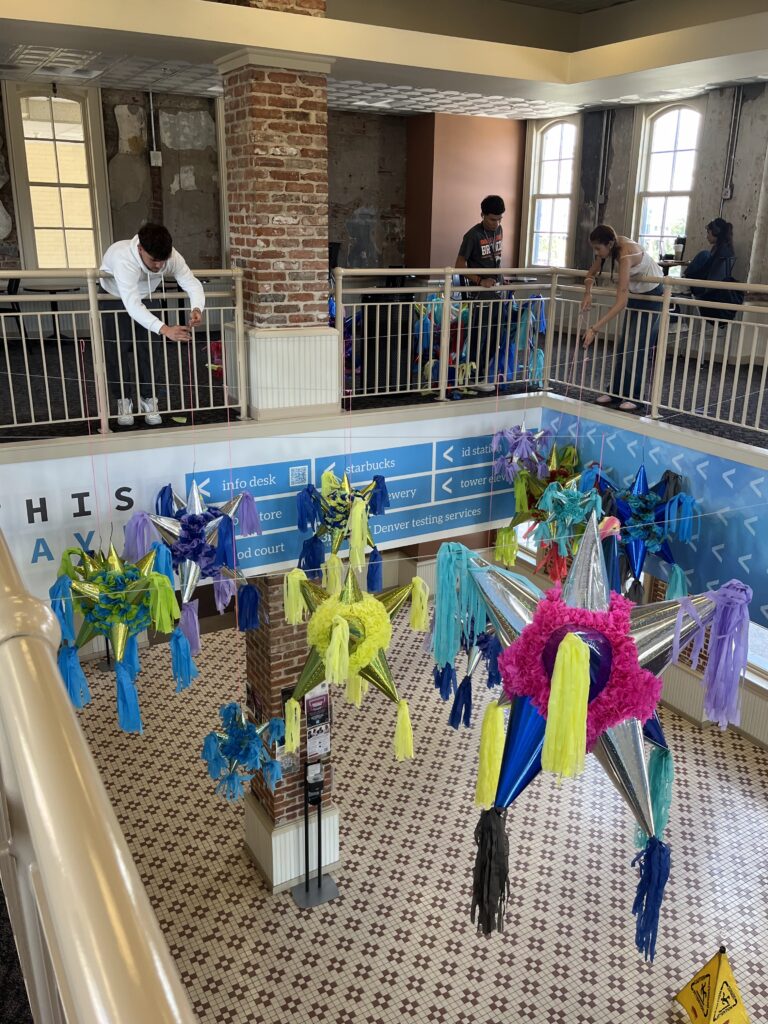
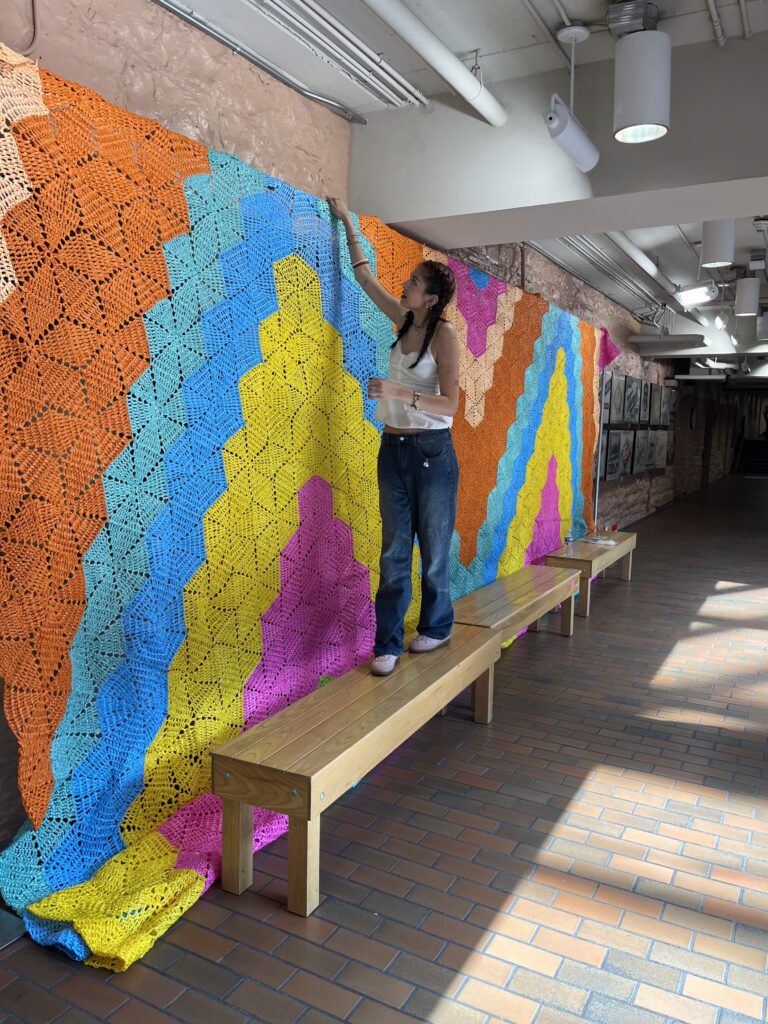
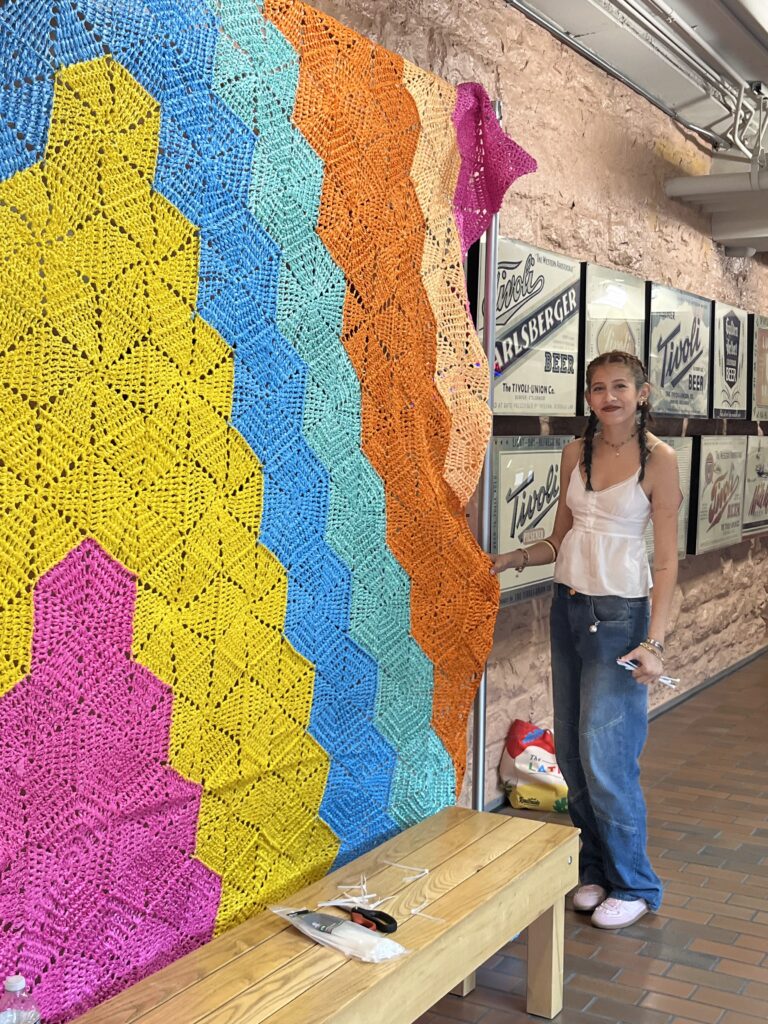
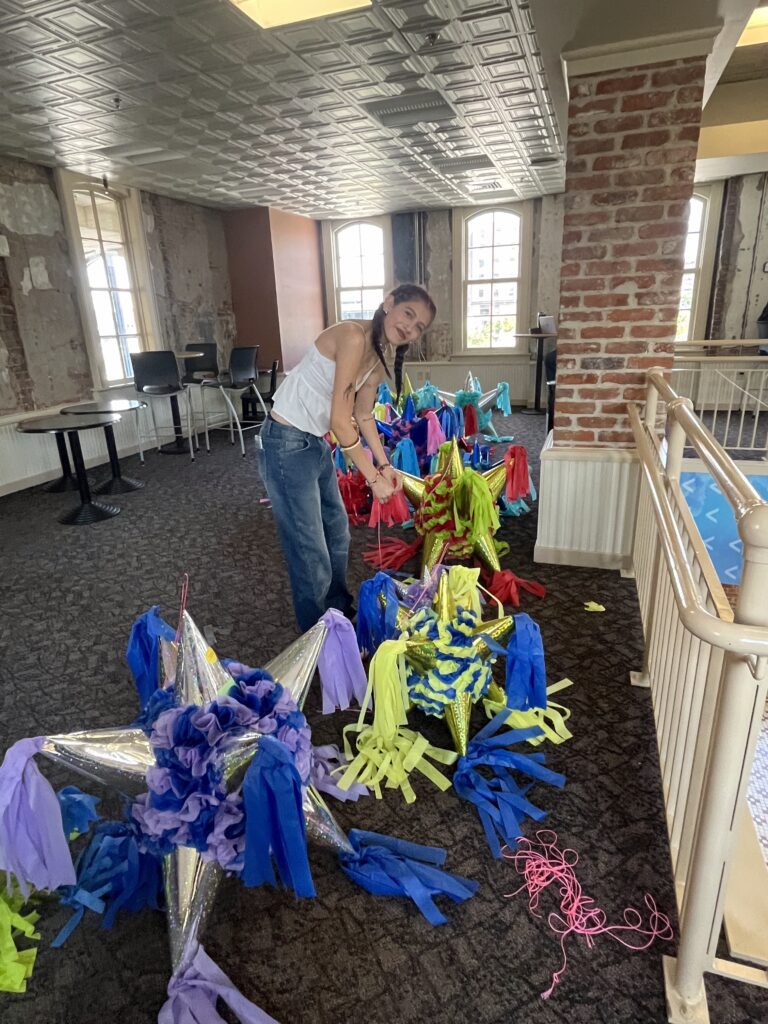
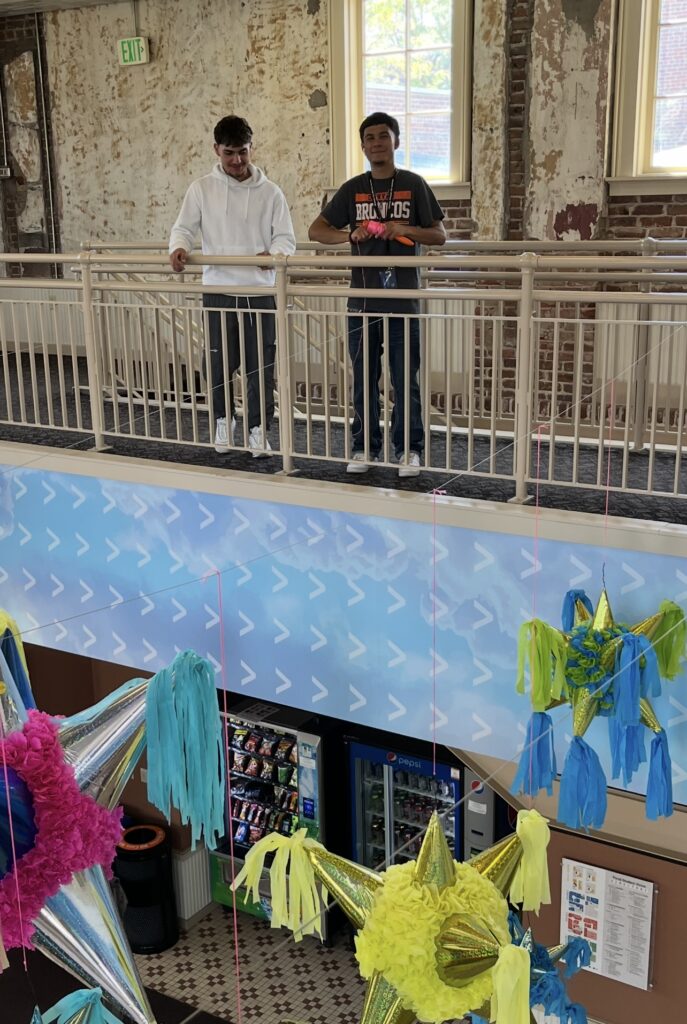
We invite you to visit campus throughout Hispanic Heritage Month to experience these meaningful installations, celebrate the history and culture of the Hispanic community, and reflect on the traditions that continue to shape our world today.